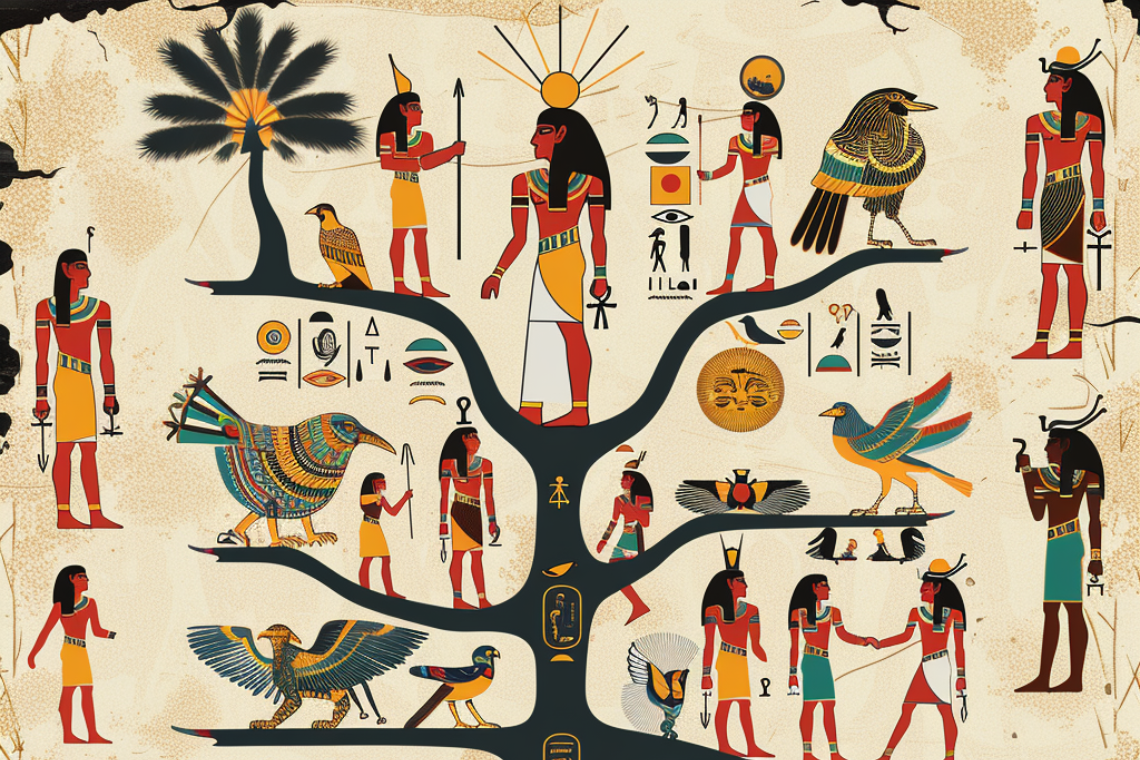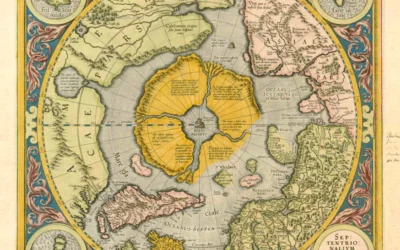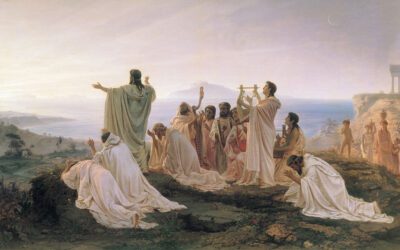Exploring Permanence in Egyptian Mythology

Egyptian architecture with its bold forms and slow lines is still associated and used to envoke power and formalism through structure. Egyptian mythology, like the civilization that produced it, is steeped in notions of permanence, eternity, and cosmic order. This focus on permanence is understandable when one considers Egypt’s geographical and political context: a kingdom bound to the cyclical flooding of the Nile, subject to occasional famine or drought, and ruled by dynasties often maintained through fragile familial lines. Egyptian mythology reinforced the idea of stability and unchanging continuity, especially through its pantheon of gods, who were seen as embodiments of eternal truths rather than agents of constant change or rebellion, as is common in many other mythological systems. This focus on cosmic and imperial permanence is evident in the mythology’s treatment of the divine realm, its emphasis on the afterlife, and the symbolic significance of the Pharaoh as both a political and spiritual leader.
Mythology Series
The Nile and the Cosmos: The Necessity of Stability
The Egyptian empire’s dependency on the Nile River cannot be overstated. The annual flooding of the Nile, which replenished the soil with nutrient-rich silt, was both a blessing and a curse—essential for agricultural fertility yet unpredictable and capable of causing devastation. This precarious balance between life-giving waters and potential chaos is echoed in Egyptian mythology, where gods like Osiris and Hapi (god of the Nile) were revered as sources of life and order. However, unlike the mythological cycles found in cultures such as the Greeks or Norse, the emphasis in Egyptian mythology was not on renewal through destruction, but rather on preserving balance and continuity in the face of potential disaster.
The central myth of Osiris’s death and resurrection, for example, was not seen as a story of cyclical regeneration but rather one of eternal preservation. Osiris, once resurrected, ruled as the god of the dead in the afterlife, maintaining the eternal order of the cosmos. His son, Horus, inherited his role in the living world, reinforcing the concept of eternal rulership passed down through dynasties, much like the pharaonic system. The mythological emphasis here was on ensuring continuity—not just between life and death, but also between the divine and human realms.
Permanence Through the Pantheon: Gods as Immutable Forces
The gods of Egypt were not capricious or trickster-like figures as seen in other mythologies. Instead, they represented eternal and unchanging principles. Ra, the sun god, epitomized this permanence. His daily journey across the sky, and his nightly battle in the underworld to ensure the sun’s rise each morning, was a powerful symbol of the unbroken cycle of day and night, life and death. Ra’s power was absolute, and while he faced challenges in the underworld, his victory was never in doubt, reinforcing the belief in an unshakable cosmic order.
Similarly, Ma’at, the goddess of truth, balance, and justice, symbolized the cosmic force of order that kept the universe and society functioning. Ma’at was not merely an abstract concept but was seen as a force that the Pharaohs themselves had to embody and uphold. The idea of maintaining Ma’at was central to Egyptian governance and religious practices. Pharaohs were often depicted as being the earthly embodiment of divine order, reinforcing the idea that the empire itself, much like the heavens, was meant to last eternally under divine favor.
This is in contrast to mythologies such as those of the Greeks or Mesopotamians, where gods frequently challenged each other, disrupted cosmic order, or embodied human-like flaws and chaos. Egyptian gods rarely operated in such a way. Even the chaos god Seth, who murdered Osiris, was later integrated into the pantheon as a necessary, albeit dangerous, aspect of cosmic balance. This speaks to the Egyptian view that even chaos was a force that needed to be controlled and subsumed into the eternal order, not celebrated for its potential to bring about renewal or change.
The Afterlife: An Eternal Journey, Not a Rebirth
One of the most distinctive aspects of Egyptian mythology is its treatment of the afterlife. The Egyptians did not conceive of the afterlife as a place of spiritual transformation or rebirth, but rather as a continuation of life, albeit in a perfected, eternal form. The elaborate burial practices, mummification, and the construction of monumental tombs like the pyramids were all efforts to ensure that the dead could live forever in the afterlife, unchanged and eternal.
The “Book of the Dead” serves as a guide for the deceased to navigate the afterlife, emphasizing the importance of maintaining one’s identity and soul intact. In contrast to mythologies that focus on reincarnation or cycles of rebirth (such as Hindu or Buddhist traditions), the Egyptian afterlife was not about returning to the world of the living. It was about achieving a perfected state of eternal existence in the Field of Reeds, a heavenly realm where the dead lived forever in peace and prosperity, much as they had in life.
Osiris’s role as the god of the afterlife further emphasized the idea of permanence. As the ruler of the dead, he was not a figure of renewal but of eternal kingship, presiding over a realm where time did not progress, and where the righteous dead could continue their existence forever. This mythological framework supported the broader Egyptian worldview that the empire, much like the gods and the afterlife, was eternal and unchanging.
Dynasties and Divine Legitimacy: Reinforcing Continuity
The Egyptian dynasties, often maintained through inbreeding to preserve the royal bloodline, reflect the same obsession with continuity and permanence. Pharaohs were considered divine, the living incarnations of gods, particularly Horus during their lives and Osiris after death. The interconnections between gods, rulers, and empire were designed to ensure that the world order was eternal and impervious to the disruptions of time or external threat. Pharaohs’ divine status was often reaffirmed through the construction of temples, monuments, and grand tombs, which served both as acts of devotion and as reminders of the ruler’s eternal nature.
This desire for permanence can be seen most dramatically in the construction of the pyramids, monumental tombs that were designed to last for eternity. The pyramids were not merely places to house the dead but were also symbols of the eternal nature of the Pharaoh’s rule and the enduring stability of the Egyptian empire. The continuity of the dynasty, much like the Nile’s yearly flood, was a sacred guarantee that the cosmos itself would remain intact.
The Gods as Symbols of Cosmic and Imperial Permanence
In conclusion, Egyptian mythology is a complex system designed to reinforce the idea of cosmic and imperial permanence. The gods themselves were not agents of change but instead embodied eternal principles that guaranteed the stability of the cosmos, the empire, and the afterlife. Egyptian myths offered a vision of an unchanging and unbroken reality where the forces of chaos were not celebrated or revered but rather integrated into a grander, eternal order. The emphasis on permanence is evident in every aspect of Egyptian religion and governance, from the eternal journey of the sun god Ra to the eternal life promised in the afterlife, and from the divine right of the Pharaoh to the monumental structures that continue to stand as testaments to the Egyptian belief in the unchanging and eternal.
Ra: The Sun God and Eternal Order
Ra, the sun god, was the central figure in Egyptian mythology, embodying the life-sustaining and eternal qualities of the sun. Every day, Ra sailed across the sky, and each night, he descended into the underworld to battle the forces of chaos, ensuring that the sun would rise again in the morning. Ra’s journey represented not just the daily cycle of day and night but the unbreakable, eternal nature of cosmic order.
Equivalents in Other Pantheons:
- Greek: Helios, the sun god, who similarly traversed the sky in a chariot, represents the daily passage of the sun. However, Ra’s role was more cosmic and permanent than Helios, whose myths don’t emphasize the battle with chaos.
- Hindu: Surya, the solar deity, shares similarities with Ra in terms of representing cosmic light and order, but Ra’s unchallenged and eternal rule is unique.
Therapeutic Symbolism and Self-Representation:
Ra symbolizes the higher self, the part of the psyche that connects with the divine and the source of life. In therapy, Ra could be used as a symbol of stability and hope, especially for those seeking grounding in the face of life’s uncertainties. His battle against chaos each night could represent the human struggle against inner darkness, depression, or instability, with the understanding that renewal and light are always possible.
Osiris: The God of the Afterlife and Resurrection
Osiris, the god of the dead and the afterlife, was central to Egyptian beliefs about life after death. His myth involves his murder by his brother Seth, his resurrection by his wife Isis, and his eternal role as the king of the underworld. Unlike myths in other cultures where resurrection might symbolize renewal or change, Osiris’s resurrection was more about permanence. Once resurrected, Osiris did not return to the world of the living but became a symbol of eternal kingship and stability in the afterlife.
Equivalents in Other Pantheons:
- Greek: Hades, the god of the underworld, represents a similar role as a ruler of the dead, but Osiris differs in that he was resurrected and continued to rule as a more positive, revered figure.
- Norse: Baldr, who was also killed and sent to the underworld, shares some symbolic connections with Osiris in the hope for resurrection, although in Norse myth, Baldr’s return is tied to the world’s rebirth after Ragnarok.
Therapeutic Symbolism and Self-Representation:
Osiris represents the aspect of the self concerned with death, grief, and legacy. In therapeutic contexts, Osiris can be a comforting figure for those dealing with loss or existential questions about death, offering a narrative of continuity and eternal life. His myth of being pieced back together by Isis can symbolize the integration of fragmented aspects of the self during therapy, a process of becoming whole again after trauma or significant loss.
Isis: The Divine Mother and Healer
Isis, the wife of Osiris and mother of Horus, is one of the most beloved figures in Egyptian mythology. She was not only the goddess of magic and healing but also the archetype of the divine mother. Her role in resurrecting Osiris and protecting her son Horus from Seth emphasized her nurturing and protective nature. Isis was associated with fertility, motherhood, and the power of healing through magic, embodying the timeless qualities of care and protection.
Equivalents in Other Pantheons:
- Greek: Demeter, the goddess of agriculture and motherhood, shares a similar role as a nurturing, protective figure. However, Isis’s association with magic adds a dimension of divine power to her motherhood that is unique.
- Roman: Juno, the queen of the gods, shares Isis’s maternal and protective characteristics, although Juno’s role is more focused on the political aspects of marriage and queenship.
Therapeutic Symbolism and Self-Representation:
In therapy, Isis represents the nurturing aspect of the psyche—the inner mother who heals and protects. She can be invoked as a symbol of the healing process, especially for individuals working through issues related to caregiving, nurturing, and self-compassion. For those experiencing feelings of abandonment or betrayal, her story of restoring Osiris and protecting Horus offers a model of perseverance, loyalty, and healing.
Horus: The Avenger and Divine Kingship
Horus, the falcon-headed god, was the son of Isis and Osiris and represented the living Pharaoh. His myth involves avenging his father’s death by defeating Seth, thus restoring order to the cosmos. As the god of kingship, Horus was both a symbol of divine authority and the protector of the Pharaoh. His victory over Seth was seen as a triumph of order over chaos, further reinforcing the idea of permanence and stability in both the heavens and on earth.
Equivalents in Other Pantheons:
- Greek: Zeus shares some similarities with Horus, especially in his role as the ruler of the gods and his association with kingship and order. However, Horus is a more direct representative of earthly kingship than Zeus.
- Norse: Thor, the god of thunder, is similar to Horus in that he is a protector figure who fights against chaos (the giants in Norse mythology), representing order and stability.
Therapeutic Symbolism and Self-Representation:
Horus represents the part of the self that seeks justice, protection, and the establishment of boundaries. In therapy, Horus could be used to explore themes of empowerment, standing up to adversity, and reclaiming personal power. His myth of avenging his father also touches on themes of resolving family dynamics and conflicts, making him a useful figure for individuals working through intergenerational trauma or power struggles within families.
Seth: The God of Chaos and Necessary Evil
Seth, the god of chaos, storms, and deserts, stands in contrast to the other gods as the embodiment of disorder and destruction. Yet, he was not simply a villain; in later Egyptian mythology, Seth was also a necessary force, representing the challenges and disruptions that were integral to maintaining balance in the universe. His chaotic nature was acknowledged and controlled, but not eliminated, highlighting the Egyptian understanding that even chaos had its place within the eternal order.
Equivalents in Other Pantheons:
- Greek: Ares, the god of war, shares Seth’s chaotic and destructive nature, though Seth’s role is broader as he encompasses natural chaos as well as human conflict.
- Norse: Loki, the trickster god, represents similar forces of chaos and disruption, but while Loki’s role is often to upend order, Seth’s role eventually became integrated into the balance of the cosmos.
Therapeutic Symbolism and Self-Representation:
Seth can be understood as the shadow aspect of the psyche—the part that deals with chaos, destruction, and conflict. In therapeutic contexts, Seth represents the necessity of confronting and integrating the darker, more disruptive aspects of one’s personality. For individuals dealing with anger, trauma, or feelings of being out of control, Seth offers a model for understanding how chaos can be managed rather than eradicated, allowing for a healthier balance between order and disorder in the self.
Anubis: The Guardian of the Dead and Guide to the Afterlife
Anubis, the jackal-headed god, was the protector of graves and the guide for souls entering the afterlife. He was responsible for weighing the hearts of the dead against the feather of Ma’at to determine their worthiness to enter the eternal afterlife. Anubis’s role emphasized the importance of moral order and judgment, reinforcing the idea that the afterlife was a place of eternal permanence for the righteous, while the unworthy faced annihilation.
Equivalents in Other Pantheons:
- Greek: Hermes, in his role as psychopomp, shares Anubis’s role as a guide for souls to the afterlife, though Anubis’s connection to judgment is unique.
- Hindu: Yama, the god of death and the judge of the dead, has similarities with Anubis in overseeing the moral judgment of souls after death.
Therapeutic Symbolism and Self-Representation:
Anubis represents the inner guide and moral compass. In therapy, he can be used to explore themes of judgment, morality, and the journey through life’s transitions. For individuals grappling with guilt, shame, or moral dilemmas, Anubis offers a framework for self-examination and the weighing of one’s actions. His role as a psychopomp also makes him a figure for guiding individuals through difficult transitions, both in life and in therapy.
Bibliography and Further Reading
- Primary Sources on Egyptian Mythology:
- Faulkner, Raymond O., trans. The Egyptian Book of the Dead: The Book of Going Forth by Day. Chronicle Books, 2015.
- A key text offering insight into Egyptian beliefs about the afterlife and the role of Osiris in ensuring eternal life.
- Pinch, Geraldine. Egyptian Mythology: A Guide to the Gods, Goddesses, and Traditions of Ancient Egypt. Oxford University Press, 2004.
- A comprehensive resource on Egyptian deities and their role in maintaining the cosmic order.
- Lichtheim, Miriam. Ancient Egyptian Literature: Volume I: The Old and Middle Kingdoms. University of California Press, 2006.
- This collection provides access to a wide range of Egyptian mythological texts, shedding light on how they conveyed ideas of permanence and stability.
- Faulkner, Raymond O., trans. The Egyptian Book of the Dead: The Book of Going Forth by Day. Chronicle Books, 2015.
- The Role of the Nile in Egyptian Religion:
- Wilkinson, Richard H. The Complete Gods and Goddesses of Ancient Egypt. Thames & Hudson, 2003.
- An excellent guide to the pantheon of Egyptian gods, with an emphasis on how deities like Hapi and Osiris were connected to the Nile and agricultural fertility.
- Hoffmeier, James K. The Nile in Egyptian Religion: Sacred Waters and Divine Kingship. Paulist Press, 2008.
- A detailed exploration of the religious significance of the Nile and its importance to the stability of Egyptian civilization.
- Wilkinson, Richard H. The Complete Gods and Goddesses of Ancient Egypt. Thames & Hudson, 2003.
- Pharaohs and Divine Kingship:
- Wilkinson, Toby. The Rise and Fall of Ancient Egypt. Random House, 2010.
- This book provides a comprehensive history of the Egyptian empire, focusing on the role of the Pharaohs in maintaining divine order and permanence.
- Kemp, Barry J. Ancient Egypt: Anatomy of a Civilization. Routledge, 2018.
- A study of Egyptian governance, emphasizing the Pharaoh’s divine right to rule and how this reflected the myths of divine kingship.
- Wilkinson, Toby. The Rise and Fall of Ancient Egypt. Random House, 2010.
- Death and the Afterlife in Egyptian Mythology:
- Taylor, John H. Death and the Afterlife in Ancient Egypt. University of Chicago Press, 2001.
- A key text that delves into Egyptian burial practices, mummification, and the mythology surrounding the afterlife.
- Assmann, Jan. The Search for God in Ancient Egypt. Cornell University Press, 2001.
- This work explores the theological and cosmological concepts of eternity and permanence in Egyptian religion, particularly through the lens of the afterlife.
- Taylor, John H. Death and the Afterlife in Ancient Egypt. University of Chicago Press, 2001.
- Cosmic Order and Ma’at:
- Hornung, Erik. Conceptions of God in Ancient Egypt: The One and the Many. Cornell University Press, 1983.
- A study of Egyptian religious philosophy, focusing on the centrality of Ma’at and cosmic order.
- Quirke, Stephen. The Cult of Ra: Sun-Worship in Ancient Egypt. Thames & Hudson, 2001.
- A detailed look at Ra’s role in maintaining the eternal cycle of day and night, reflecting the Egyptian emphasis on permanence.
- Hornung, Erik. Conceptions of God in Ancient Egypt: The One and the Many. Cornell University Press, 1983.
- Permanence and Architecture:
- Lehner, Mark. The Complete Pyramids: Solving the Ancient Mysteries. Thames & Hudson, 1997.
- An in-depth analysis of the pyramids as symbols of eternal kingship and the Egyptian desire for immortality.
- Arnold, Dieter. Temples of Ancient Egypt. Cornell University Press, 1999.
- This book explores how temple architecture reinforced the idea of divine permanence and continuity.
- Lehner, Mark. The Complete Pyramids: Solving the Ancient Mysteries. Thames & Hudson, 1997.
- Chaos and Stability in Egyptian Mythology:
- Assmann, Jan. The Mind of Egypt: History and Meaning in the Time of the Pharaohs. Harvard University Press, 2003.
- A rich exploration of how Egyptian religion and mythology were used to reinforce ideas of cosmic and political order.
- Teeter, Emily. Religion and Ritual in Ancient Egypt. Cambridge University Press, 2011.
- An accessible yet scholarly look at how religious rituals supported the mythological narrative of eternal stability.
- Assmann, Jan. The Mind of Egypt: History and Meaning in the Time of the Pharaohs. Harvard University Press, 2003.
- Comparative Mythology:
- Leeming, David A. The Oxford Companion to World Mythology. Oxford University Press, 2005.
- Provides context on how Egyptian mythology compares to other world mythologies, particularly in terms of the emphasis on permanence versus change.
- Armstrong, Karen. A Short History of Myth. Canongate, 2005.
- A brief but insightful overview of global mythological systems, including Egypt, with a focus on their cultural significance.
- Leeming, David A. The Oxford Companion to World Mythology. Oxford University Press, 2005.
- Online Resources for Further Exploration:
- The Griffith Institute’s Online Egyptology Resources
- http://www.griffith.ox.ac.uk/gri/
- Offers access to academic papers, texts, and resources for studying Egyptian religion and mythology.
- Egyptian Mythology Podcast
- https://egyptianmythology.co/podcast
- A comprehensive podcast series exploring various Egyptian myths and their cultural and historical context.
- The Griffith Institute’s Online Egyptology Resources
- YouTube Channels for Visual Learning:
- The British Museum’s Ancient Egypt Collection – YouTube Playlist
- https://www.youtube.com/playlist?list=PLb71y7Zdn9Z8_5o8E_4bqZKg5G8FNhx2O
- Offers videos and lectures on ancient Egyptian artifacts, culture, and mythology, highlighting the concept of permanence in religion and governance.
- The Egypt Exploration Society
- https://www.youtube.com/user/EgyptExplorationSoc
- A resource with lectures and discussions on various topics related to ancient Egypt, including its mythology.
- The British Museum’s Ancient Egypt Collection – YouTube Playlist


























0 Comments